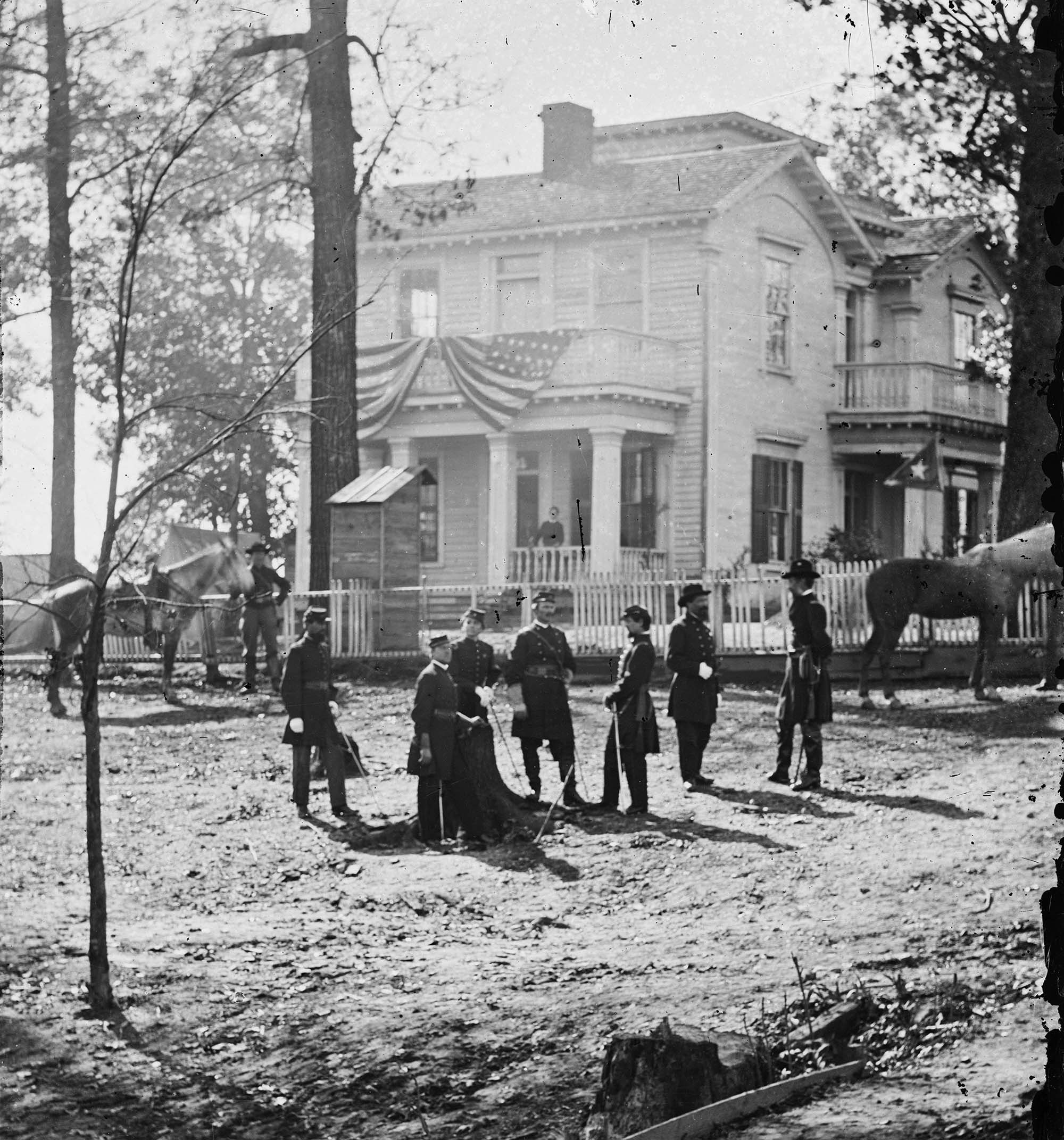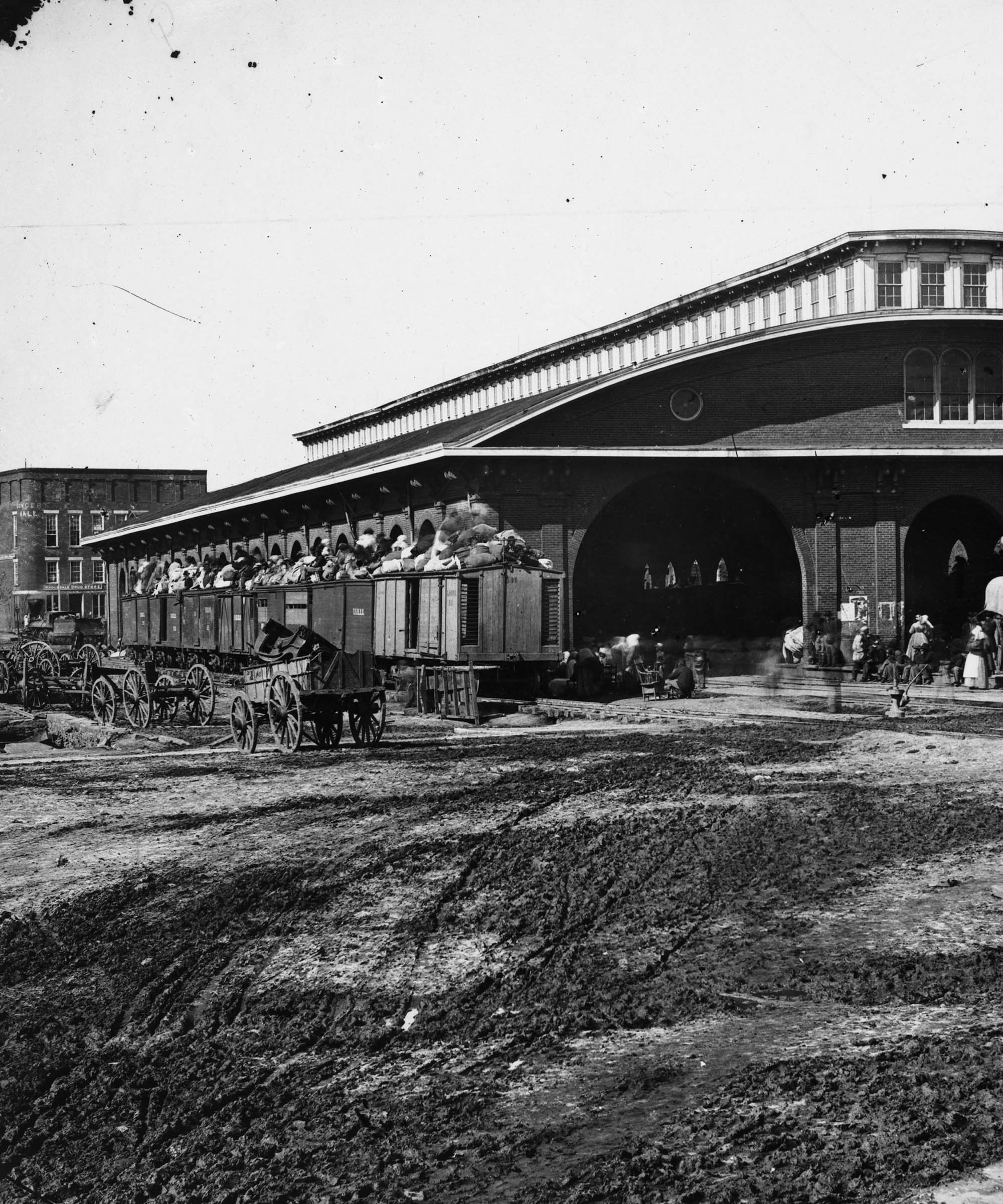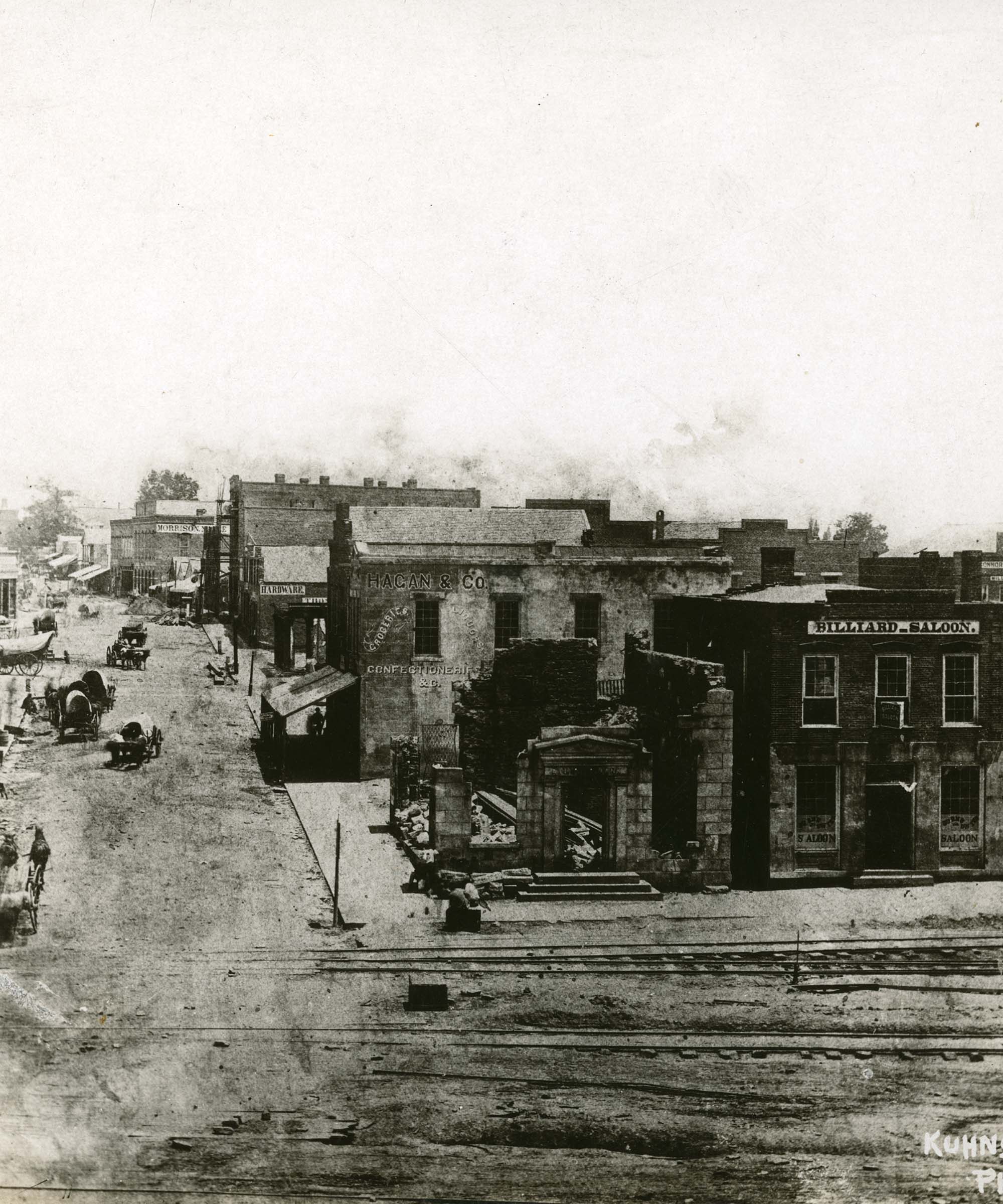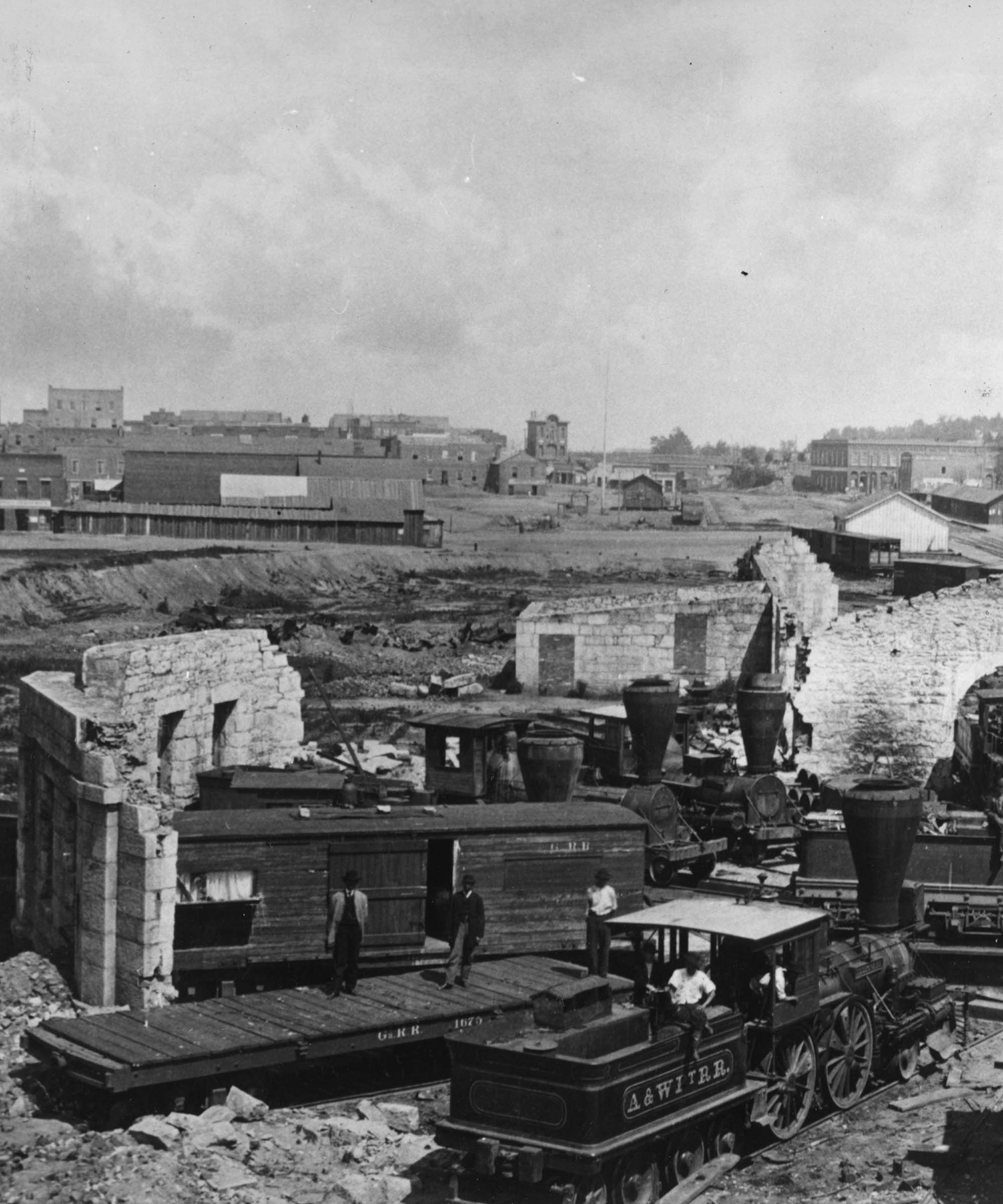
Union officers occupied a house that formerly served as Confederate army headquarters in Atlanta. 
Cut off from all lines of supply, the Confederate army was forced to evacuate or risk being trapped in the city and starving. Hood ordered a retreat on Sept. 1, and by midnight the last of his infantry units were marching down the McDonough Road (present-day Capitol Avenue and McDonough Boulevard) and out of town.
The next day, Mayor James Calhoun made a decision with a spin worthy of future Atlanta leaders. With his Southern defenders gone, Calhoun chose a delegation of citizens with pro-Union sentiments -- including a slave, Robert Yancey. The group rode north beyond the city limits and past the abandoned Confederate trenches in search of the Union army. Finding a captain at the present-day corner of Northside Drive and Marietta Street, Calhoun formally surrendered Atlanta.
Later that afternoon, the Stars and Stripes flew over the city for the first time in more than three years.
35,707 pounds of gunpowder total
With the Union holding the railroads, the retreating Confederates had no way of removing their ammunition train. Rather than let it fall into enemy hands, the Rebels blew it up at midnight of Sept. 2. A study of Confederate munitions records reveals 18 tons of gunpowder were loaded within 28 box cars.
The resulting explosions -- a scene dramatized in "Gone With The Wind" -- were heard by Sherman over 15 miles away in Jonesboro. The blasts destroyed or heavily damaged all homes and buildings within a quarter-mile. Fortunately, all residents had been ordered to leave the area -- today's intersection of DeKalb Avenue and Boulevard -- prior to the demolition. The map shows the impact zone projected against the present-day neighborhood.
Sherman and emancipation in Atlanta.
The fall of Atlanta was a crushing blow to the morale of white Southerners, and all the more to Georgians who had staked everything on the Confederacy.
To thousands of African-American slaves, however, Union forces arrived not as conquerors but as liberators. Though the majority of enslaved Atlantans left in voluntary and forced evacuations before the city’s fall, the Union occupation served as a beacon of freedom to those slaves remaining in the surrounding region. Following Atlanta’s fall, a significant and steadily growing number of African-Americans made their way to the city.
Their stay wouldn't last long.

Clark Atlanta University's roots go back to the end of the war, when Atlanta University was established. After emancipation, thousands of freedmen poured into Atlanta, not only seeking work but educational opportunities as well. They formed the basis of a large and ultimately influential black community that thrives today. CAU is now part of the Atlanta University Center.

Eyewitness illustration of Atlanta residents preparing to evacuate.
Sherman declared Atlanta a U.S. military outpost, meaning all civilians had to leave -- black and white, pro-Union and pro-Confederate, old and young alike.
His expulsion order of Sept. 7 offered the few thousand non-combatants in Atlanta a choice. Those with Rebel sympathies would be escorted south to Confederate lines, including any slaves who wished to remain with their masters (a violation of the Emancipation Proclamation in spirit, if not law). Those who were Union loyalists, including the newly emancipated, would be put on north-bound trains.
Total people: 1651
Adults: 705
Children: 860
Servants: 86
Bags: 8842
Horses: 9
Cattle: 25
Wagons: 2
Carts: 2
Carriage: 1
Buggy: 1
The exact number of people, black and white, who chose to go north during the evacuation is unknown. Union officers, however, compiled a list of Atlantans and their property that were escorted southward to Confederate lines.The group included 86 slaves who chose to remain with their masters.
Only around 50 families and an unknown number of freed slaves either were allowed to remain or did so without permission.


Just as it had for the Confederacy, Atlanta’s train network played a key role for the Union during Sherman’s occupation. Trains ferried civilians out of town during the evacuation, and kept Union troops supplied. 
Union occupation lasted over two months as Sherman planned his next move. The course he chose, his legendary March to the Sea, meant abandoning Atlanta to Confederate reoccupation.
Yet Sherman made sure the city would have no military value. In November, he ordered the destruction of any part that could be used for that purpose.
Though the final burning is the focus of many history books, the overall destruction occurred over many months. It started when Confederates began stripping and leveling houses to build fortifications. Union artillery struck most major structures, setting many afire. When the Confederates made their retreat, they destroyed not only their ammunition train, but the huge Atlanta Machine Works factory. Looters and arsonists from both armies took a toll, and Union occupiers ripped apart more property to construct new forts and shelters.
A precise number will never be known, but the best estimate is that 40 percent of all homes and buildings were destroyed.
This map shows areas destroyed from all events in 1864. Use the filter button above  to edit which categories you want to display. Zoom out for outlying railroads.
to edit which categories you want to display. Zoom out for outlying railroads.
Union occupation lasted over two months as Sherman planned his next move. The course he chose, his legendary March to the Sea, meant abandoning Atlanta to Confederate reoccupation.
Yet Sherman made sure the city would have no military value. In November, he ordered the destruction of any part that could be used for that purpose.
Though the final burning is the focus of many history books, the overall destruction occurred over many months. It started when Confederates began stripping and leveling houses to build fortifications. Union artillery struck most major structures, setting many afire. When the Confederates made their retreat, they destroyed not only their ammunition train, but the huge Atlanta Machine Works factory. Looters and arsonists from both armies took a toll, and Union occupiers ripped apart more property to construct new forts and shelters.
A precise number will never be known, but the best estimate is that 40 percent of all homes and buildings were destroyed.



Destroyed landmarks included the train terminal, the Georgia Railroad Bank, and a locomotive roundhouse. 

A poster from Lincoln’s Democratic opponent, George McClellan. Though the former general was still popular within the military, Lincoln won over 70 percent of the Union army vote.
Atlanta's capture had immediate repercussions. In the South, beyond the devastating impact on white morale, the loss of Atlanta effectively ended the Confederacy's ability to efficiently supply its army in the West. Conversely, the victory electrified the North, where celebratory 100-cannon salutes were enacted from Boston to Washington. People who previously questioned whether the war could be won now believed otherwise.
Also, unlike the horrifying casualties suffered by the Army of the Potomac as it tried to capture Richmond at the same time, Sherman had won without a huge sacrifice of life. His flanking tactics, which avoided assaulting Atlanta's defenses directly, had paid off.
Lincoln, so pessimistic about his chances just months earlier, easily beat George McClellan on Election Day to become the first U.S. president re-elected in 32 years.
The Union's prosecution of the war would continue, and the outcome was no longer in doubt. To either side.